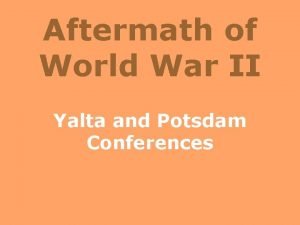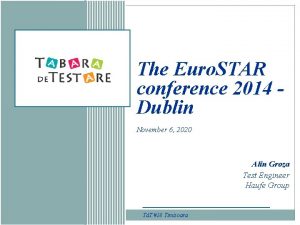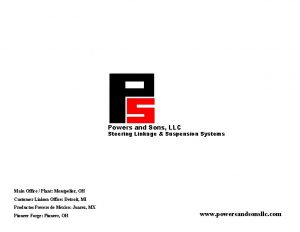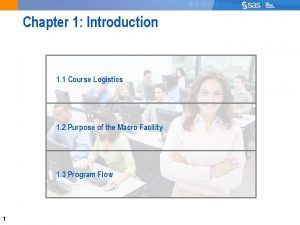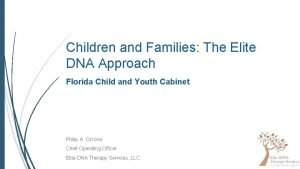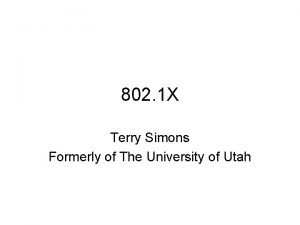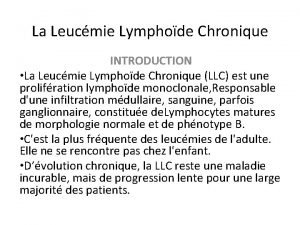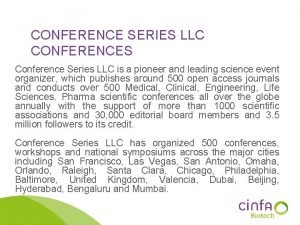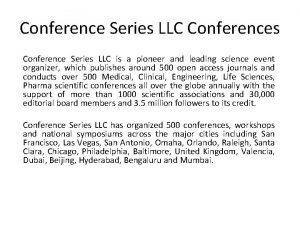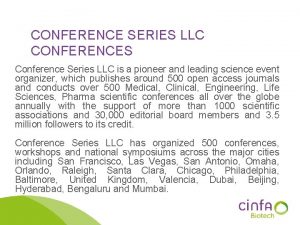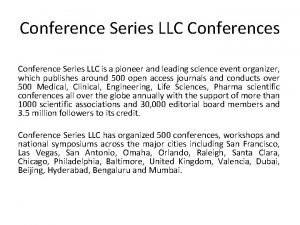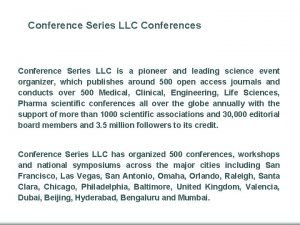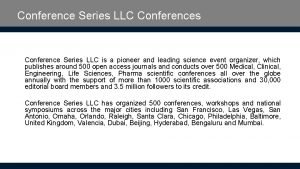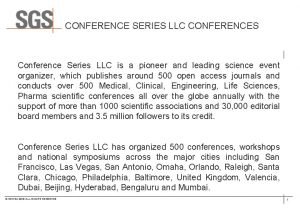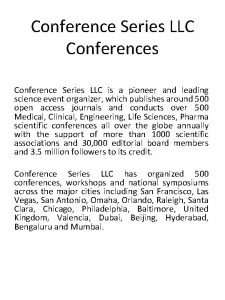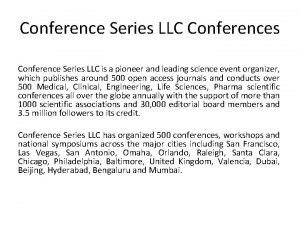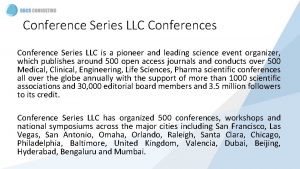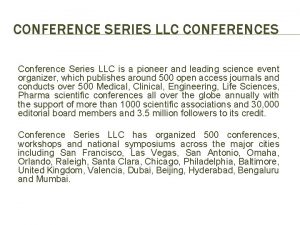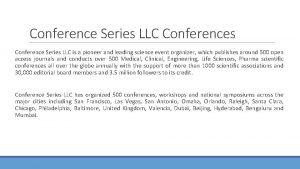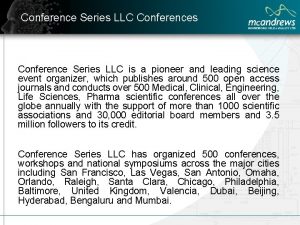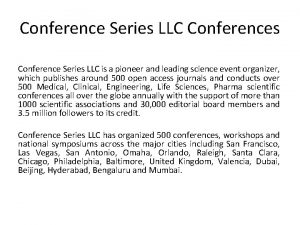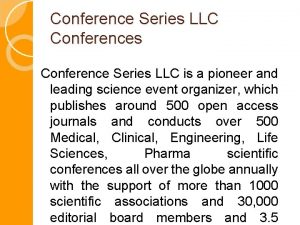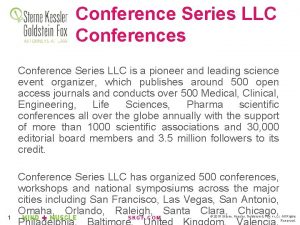Conference Series LLC Conferences Conference Series LLC is
































- Slides: 32

Conference Series LLC Conferences Conference Series LLC is a pioneer and leading science event organizer, which publishes around 500 open access journals and conducts over 500 Medical, Clinical, Engineering, Life Sciences, Pharma scientific conferences all over the globe annually with the support of more than 1000 scientific associations and 30, 000 editorial board members and 3. 5 million followers to its credit. Conference Series LLC has organized 500 conferences, workshops and national symposiums across the major cities including San Francisco, Las Vegas, San Antonio, Omaha, Orlando, Raleigh, Santa Clara, Chicago, Philadelphia, Baltimore, United Kingdom, Valencia, Dubai, Beijing, Hyderabad, Bengaluru and Mumbai.

Measuring the rate of therapeutic adherence among outpatients with T 2 DM in Egypt By Dr. Inas Barakat Associate professor of internal medicine, Mansoura University, Egypt Taiba University, KSA

INTRODUCTION Medication adherence is defined as the extent to which a person’s medication use behavior coincides with medical or health advice; and persistence as the duration of time from initiation to discontinuation of therapy* *Cramer et al. , 2008.

INTRODUCTION • Adherence is the active, voluntary involvement of the patient in the management of his or her disease, which requires the patient's agreement to the recommendations given by the health care provider • Compliance is a passive process of following the instructions made by the health care provider.

INTRODUCTION • it is considered as an integral component of pharmaceutical care practice & patient healthcare*. • It has been shown that despite effective methods of treatment, Optimal glucose control can be achieved through strict adherence to medications, diet, & life style modifications that in turn minimizes long-term complications**. *Arun et al. , 2008 **Schectman-Joel et al. , 2002; Rickles et al. , 2010

INTRODUCTION • Adherence to long-term therapy for chronic illnesses in developed countries averages 50%. In developing countries, the rates are even lower. • Poor adherence to long-term therapies severely compromises the effectiveness of treatment making this a critical issue in population health both from the perspective of quality of life and of health economics.

Therapeutic Non-Adherence • Medication non-adherence: Failure to have the prescription dispensed or renewed, omission of doses, errors of dosage, incorrect administration, errors in the time and frequency of administration, and premature discontinuation of the drug regimen. • Dietary/exercise non-adherence: failure to follow the diet and exercise recommendations. • Appointment non-adherence: failure to show up at the clinics for the scheduled check up. * * Clark and Forwell, 2000

Aim of the study This study sought to examine the rate of medication adherence and different factors affecting it among Type 2 diabetic patients in Egypt From November 2007 to March 2008, a total 226 patients were recruited in the current study. AIM

Study Design: Patients Selection • They were randomly selected from the Outpatient Clinics of Internal Medicine Department at Specialized Medical Hospital at University of Mansoura, Egypt. • Inclusion criteria were: • Patients >18 years of age, • Diagnosed with T 2 DM at least one year earlier, • Received oral hypoglycemic medication* • Didn't use insulin or suffer from chronic complications, • consented to participate in the study. *sulphonylurea or/and biguanide

Assessment of therapeutic Adherence • Socio-demographic patient profile; • Level of knowledge about DM, its causes, principles of drug therapy & complications of drug therapy as well as patients’ beliefs & motivation about provider relationship, • Regularity of monitoring of blood glucose level, • Drug-related factors like access to & use of medicines, number of medication therapy taken, complexity of drug regimen, presence of drug side effects, and cost of treatment in relation to patient income; • Assessment of patient adherence to diet restrictions, exercise, and appointment for regular checkup in the clinics.

Measure Treatment Adherence (MTA) Scale: * • Have you ever forgotten to take your medicines? • Were you careless at times about taking your medicines? • When you felt better, did you sometimes stop taking your medicines? • Sometimes, if you felt worse, did you stop taking your medicines? • Have you ever discontinued treatment because you ran out of pills? • Have you ever stopped taking your medicines for any reason other than a medical advisory? *Delgado and Lima (2001).

MTA Scale - allows answers from ‘‘always’’ to ‘‘never, ’’ with scores ranging from 1 to 4 points. The highest values indicate the highest level of compliance with drug treatment; - Interpreted as: • Patients collecting more than 75% of the highest points were considered in the good adherence group. • Patients collecting less than 50% of the points were considered in the non-adherence group • patients collecting between 50% and 75% of the points were considered in the poor/partial adherence group



Patients' therapeutic Adherence 30 04 114 102 88 78 52 26 0 123 64 48 36 62 41 Good Adherence Poor Adherence Non-Adherence

Treatment Adherence & Socio-demographic characteristics Number of patients (%) Variables Marital status Family support Socioeconomical level N (%)s 226 (100) Good adherence (N=88) Poor adherence (N=101) Chisquare Nonadherence (N= 37) P value Single/widowed 82 (36. 3) /divorced 18 (21. 9) 42 (51. 2) 22 (26. 8) 19. 361 <0. 01** Married 144 (63. 7) 70 (48. 6) 59 (41. 0) 15 (10. 4) Present 134 (59. 3) 64 (47. 7) 51 (38. 1) 19 (14. 2) 10. 786 <0. 01** Absent 92 (40. 7) 24 (26. 1) 50 (54. 4) 18 (19. 5) High 12 (5. 3) 8 (66. 6) 2(16. 6) 21. 389 <0. 01** Middle 58 (25. 7) 34 (58. 6) 15 (25. 8) 9 (15. 6) Low 156 (69. 0) 46 (29. 4) 84 (53. 8) 26 (16. 6. )

Treatment Adherence & Socio-demographic characteristics Number of patients (%) Variables Marital status Family support Socioeconomical level N (%)s 226 (100) Good adherence (N=88) Poor adherence (N=101) Chisquare Nonadherence (N= 37) P value Single/widowed 82 (36. 3) /divorced 18 (21. 9) 42 (51. 2) 22 (26. 8) 19. 361 <0. 01** Married 144 (63. 7) 70 (48. 6) 59 (41. 0) 15 (10. 4) Present 134 (59. 3) 64 (47. 7) 51 (38. 1) 19 (14. 2) 10. 786 <0. 01** Absent 92 (40. 7) 24 (26. 1) 50 (54. 4) 18 (19. 5) High 12 (5. 3) 8 (66. 6) 2(16. 6) 21. 389 <0. 01** Middle 58 (25. 7) 34 (58. 6) 15 (25. 8) 9 (15. 6) Low 156 (69. 0) 46 (29. 4) 84 (53. 8) 26 (16. 6. )

Treatment Adherence & Socio-demographic characteristics Number of patients (%) Variables Marital status Family support Socioeconomical level N (%)s 226 (100) Good adherence (N=88) Poor adherence (N=101) Chisquare Nonadherence (N= 37) P value Single/widowed 82 (36. 3) /divorced 18 (21. 9) 42 (51. 2) 22 (26. 8) 19. 361 <0. 01** Married 144 (63. 7) 70 (48. 6) 59 (41. 0) 15 (10. 4) Present 134 (59. 3) 64 (47. 7) 51 (38. 1) 19 (14. 2) 10. 786 <0. 01** Absent 92 (40. 7) 24 (26. 1) 50 (54. 4) 18 (19. 5) High 12 (5. 3) 8 (66. 6) 2(16. 6) 21. 389 <0. 01** Middle 58 (25. 7) 34 (58. 6) 15 (25. 8) 9 (15. 6) Low 156 (69. 0) 46 (29. 4) 84 (53. 8) 26 (16. 6. )

Treatment Adherence & Socio-demographic characteristics Number of patients (%) Variables Marital status Family support Socioeconomical level N (%)s 226 (100) Good adherence (N=88) Poor adherence (N=101) Chisquare Nonadherence (N= 37) P value Single/widowed 82 (36. 3) /divorced 18 (21. 9) 42 (51. 2) 22 (26. 8) 19. 361 <0. 01** Married 144 (63. 7) 70 (48. 6) 59 (41. 0) 15 (10. 4) Present 134 (59. 3) 64 (47. 7) 51 (38. 1) 19 (14. 2) 10. 786 <0. 01** Absent 92 (40. 7) 24 (26. 1) 50 (54. 4) 18 (19. 5) High 12 (5. 3) 8 (66. 6) 2(16. 6) 21. 389 <0. 01** Middle 58 (25. 7) 34 (58. 6) 15 (25. 8) 9 (15. 6) Low 156 (69. 0) 46 (29. 4) 84 (53. 8) 26 (16. 6. )

Treatment Adherence & Socio-demographic characteristics Gender Variables N (%)s 226 (100) Chisquare P value Male 129 (57. 1) 5. 214 0. 07 Female 97 (42. 9) 46 (47. 5) 38 (39. 1) 13 (13. 4) 56 (24. 8) 29 (51. 8) 23 (41. 1) 4 (7. 1) 7. 981 0. 09 138 (61. 0) 50 (36. 2) 62 (44. 9) 26 (18. 9) 32 (14. 2) 9 (28. 1) 16 (50. 0) 7 (21. 9) (illiterate/basic) 29 (12. 8) 7 (24. 1) 14 (48. 3) 8 (27. 6) 5. 492 0. 24 (middle level) 81 (35. 8) 30 (37. 0) 38 (47. 0) 13 (16. 0) University or more 116 (51. 4) 51 (43. 9) 49 (42. 2) 16 (13. 85) City Village 136 (60. 1) 90 (39. 9) 57 (41. 9) 31 (34. 4) 61(44. 8) 40 (44. 4) 18 (13. 2) 19 (23. 3) 2. 830 0. 243 Young group (18– 40) Age (years) Educational status Residence Patients Number (%) Good Poor Non. Adherence (N=88) (N=101) (N= 37) 42 (32. 5) 63 (48. 8) 24 (18. 7) Middle-age group (41 – 60) Elderly group (>60)

Factors Affecting Adherence. N (%)s 226 (100) Variables Patient knowledge Patients’ beliefs and motivation about OHAs Monitoring of blood glucose level Number of drug taken Drug regimen Experience side effects care costs & patient income Patients Number (%) Good Poor Non. Adherence (N=88) (N=101) (N= 37) Chi. P-value square Rich/adequate Poor Good 86 (38. 0) 140 (62. 0) 101 (44. 7) 46 (53. 5) 42 (30. 0) 64 (63. 3) 22 (25. 6) 79 (56. 4) 25 (24. 8) 18 (20. 9) 19 (13. 6) 12 (11. 9) 20. 654 46. 477 <0. 01** Weak 125 (55. 3) 24 (19. 2) 76 (60. 8) 25 (20. 0) Regular Irregular 65 (28. 7) 161 (71. 3) 43 (66. 1) 45 (27. 9) 15 (23. 1) 86 (53. 5) 7 (10. 7) 30 (18. 6) 28. 643 <0. 01** Monotherapy 87 (38. 5) 41 (47. 1) 39 (44. 8) 7 (8. 1) 9. 340 <0. 05* Combination therapy Polypharmacy Complex Simple Present Absent Adequate 46 (22. 3) 16 (34. 8) 22 (47. 9) 8 (17. 3) 93 (41. 2) 118 (52. 2) 108 (47. 8) 137 (60. 6. ) 89(39. 4) 97 (42. 9) 31 (33. 3) 31 (26. 3) 57 (52. 8) 38 (27. 7) 50 (56. 1) 56 (57. 7) 40 (43. 1) 56 (47. 5) 33 (30. 6) 74 (54. 1) 27 (30. 4) 32 (33. 0) 22 (23. 6) 31(26. 2) 18 (16. 6) 25 (18. 2) 12 (13. 5) 9 (9. 3) 16. 665 18. 725 25. 844 <0. 01** Inadequate 129 (57. 1) 32 (24. 8) 69(53. 5) 28 (21. 7)

Factors Affecting Adherence. N (%)s 226 (100) Variables Patient knowledge Patients’ beliefs and motivation about OHAs Monitoring of blood glucose level Number of drug taken Drug regimen Experience side effects care costs & patient income Patients Number (%) Good Poor Non. Adherence (N=88) (N=101) (N= 37) Chi. P-value square Rich/adequate Poor Good 86 (38. 0) 140 (62. 0) 101 (44. 7) 46 (53. 5) 42 (30. 0) 64 (63. 3) 22 (25. 6) 79 (56. 4) 25 (24. 8) 18 (20. 9) 19 (13. 6) 12 (11. 9) 20. 654 46. 477 <0. 01** Weak 125 (55. 3) 24 (19. 2) 76 (60. 8) 25 (20. 0) Regular Irregular 65 (28. 7) 161 (71. 3) 43 (66. 1) 45 (27. 9) 15 (23. 1) 86 (53. 5) 7 (10. 7) 30 (18. 6) 28. 643 <0. 01** Monotherapy 87 (38. 5) 41 (47. 1) 39 (44. 8) 7 (8. 1) 9. 340 <0. 05* Combination therapy Polypharmacy Complex Simple Present Absent Adequate 46 (22. 3) 16 (34. 8) 22 (47. 9) 8 (17. 3) 93 (41. 2) 118 (52. 2) 108 (47. 8) 137 (60. 6. ) 89(39. 4) 97 (42. 9) 31 (33. 3) 31 (26. 3) 57 (52. 8) 38 (27. 7) 50 (56. 1) 56 (57. 7) 40 (43. 1) 56 (47. 5) 33 (30. 6) 74 (54. 1) 27 (30. 4) 32 (33. 0) 22 (23. 6) 31(26. 2) 18 (16. 6) 25 (18. 2) 12 (13. 5) 9 (9. 3) 16. 665 18. 725 25. 844 <0. 01** Inadequate 129 (57. 1) 32 (24. 8) 69(53. 5) 28 (21. 7)

Factors Affecting Adherence. N (%)s 226 (100) Variables Patient knowledge Patients’ beliefs and motivation about OHAs Monitoring of blood glucose level Number of drug taken Drug regimen Experience side effects care costs & patient income Patients Number (%) Good Poor Non. Adherence (N=88) (N=101) (N= 37) Chi. P-value square Rich/adequate Poor Good 86 (38. 0) 140 (62. 0) 101 (44. 7) 46 (53. 5) 42 (30. 0) 64 (63. 3) 22 (25. 6) 79 (56. 4) 25 (24. 8) 18 (20. 9) 19 (13. 6) 12 (11. 9) 20. 654 46. 477 <0. 01** Weak 125 (55. 3) 24 (19. 2) 76 (60. 8) 25 (20. 0) Regular Irregular 65 (28. 7) 161 (71. 3) 43 (66. 1) 45 (27. 9) 15 (23. 1) 86 (53. 5) 7 (10. 7) 30 (18. 6) 28. 643 <0. 01** Monotherapy 87 (38. 5) 41 (47. 1) 39 (44. 8) 7 (8. 1) 9. 340 <0. 05* Combination therapy Polypharmacy Complex Simple Present Absent Adequate 46 (22. 3) 16 (34. 8) 22 (47. 9) 8 (17. 3) 93 (41. 2) 118 (52. 2) 108 (47. 8) 137 (60. 6. ) 89(39. 4) 97 (42. 9) 31 (33. 3) 31 (26. 3) 57 (52. 8) 38 (27. 7) 50 (56. 1) 56 (57. 7) 40 (43. 1) 56 (47. 5) 33 (30. 6) 74 (54. 1) 27 (30. 4) 32 (33. 0) 22 (23. 6) 31(26. 2) 18 (16. 6) 25 (18. 2) 12 (13. 5) 9 (9. 3) 16. 665 18. 725 25. 844 <0. 01** Inadequate 129 (57. 1) 32 (24. 8) 69(53. 5) 28 (21. 7)

Factors Affecting Adherence. N (%)s 226 (100) Variables Patient knowledge Patients’ beliefs and motivation about OHAs Monitoring of blood glucose level Number of drug taken Drug regimen Experience side effects care costs & patient income Patients Number (%) Good Poor Non. Adherence (N=88) (N=101) (N= 37) Chi. P-value square Rich/adequate Poor Good 86 (38. 0) 140 (62. 0) 101 (44. 7) 46 (53. 5) 42 (30. 0) 64 (63. 3) 22 (25. 6) 79 (56. 4) 25 (24. 8) 18 (20. 9) 19 (13. 6) 12 (11. 9) 20. 654 46. 477 <0. 01** Weak 125 (55. 3) 24 (19. 2) 76 (60. 8) 25 (20. 0) Regular Irregular 65 (28. 7) 161 (71. 3) 43 (66. 1) 45 (27. 9) 15 (23. 1) 86 (53. 5) 7 (10. 7) 30 (18. 6) 28. 643 <0. 01** Monotherapy 87 (38. 5) 41 (47. 1) 39 (44. 8) 7 (8. 1) 9. 340 <0. 05* Combination therapy Polypharmacy Complex Simple Present Absent Adequate 46 (22. 3) 16 (34. 8) 22 (47. 9) 8 (17. 3) 93 (41. 2) 118 (52. 2) 108 (47. 8) 137 (60. 6. ) 89(39. 4) 97 (42. 9) 31 (33. 3) 31 (26. 3) 57 (52. 8) 38 (27. 7) 50 (56. 1) 56 (57. 7) 40 (43. 1) 56 (47. 5) 33 (30. 6) 74 (54. 1) 27 (30. 4) 32 (33. 0) 22 (23. 6) 31(26. 2) 18 (16. 6) 25 (18. 2) 12 (13. 5) 9 (9. 3) 16. 665 18. 725 25. 844 <0. 01** Inadequate 129 (57. 1) 32 (24. 8) 69(53. 5) 28 (21. 7)

Factors Affecting Adherence. N (%)s 226 (100) Variables Patient knowledge Patients’ beliefs and motivation about OHAs Monitoring of blood glucose level Number of drug taken Drug regimen Experience side effects care costs & patient income Patients Number (%) Good Poor Non. Adherence (N=88) (N=101) (N= 37) Chi. P-value square Rich/adequate Poor Good 86 (38. 0) 140 (62. 0) 101 (44. 7) 46 (53. 5) 42 (30. 0) 64 (63. 3) 22 (25. 6) 79 (56. 4) 25 (24. 8) 18 (20. 9) 19 (13. 6) 12 (11. 9) 20. 654 46. 477 <0. 01** Weak 125 (55. 3) 24 (19. 2) 76 (60. 8) 25 (20. 0) Regular Irregular 65 (28. 7) 161 (71. 3) 43 (66. 1) 45 (27. 9) 15 (23. 1) 86 (53. 5) 7 (10. 7) 30 (18. 6) 28. 643 <0. 01** Monotherapy 87 (38. 5) 41 (47. 1) 39 (44. 8) 7 (8. 1) 9. 340 <0. 05* Combination therapy Polypharmacy Complex Simple Present Absent Adequate 46 (22. 3) 16 (34. 8) 22 (47. 9) 8 (17. 3) 93 (41. 2) 118 (52. 2) 108 (47. 8) 137 (60. 6. ) 89(39. 4) 97 (42. 9) 31 (33. 3) 31 (26. 3) 57 (52. 8) 38 (27. 7) 50 (56. 1) 56 (57. 7) 40 (43. 1) 56 (47. 5) 33 (30. 6) 74 (54. 1) 27 (30. 4) 32 (33. 0) 22 (23. 6) 31(26. 2) 18 (16. 6) 25 (18. 2) 12 (13. 5) 9 (9. 3) 16. 665 18. 725 25. 844 <0. 01** Inadequate 129 (57. 1) 32 (24. 8) 69(53. 5) 28 (21. 7)

Factors Affecting Adherence. N (%)s 226 (100) Variables Patient knowledge Patients’ beliefs and motivation about OHAs Monitoring of blood glucose level Number of drug taken Drug regimen Experience side effects care costs & patient income Patients Number (%) Good Poor Non. Adherence (N=88) (N=101) (N= 37) Chi. P-value square Rich/adequate Poor Good 86 (38. 0) 140 (62. 0) 101 (44. 7) 46 (53. 5) 42 (30. 0) 64 (63. 3) 22 (25. 6) 79 (56. 4) 25 (24. 8) 18 (20. 9) 19 (13. 6) 12 (11. 9) 20. 654 46. 477 <0. 01** Weak 125 (55. 3) 24 (19. 2) 76 (60. 8) 25 (20. 0) Regular Irregular 65 (28. 7) 161 (71. 3) 43 (66. 1) 45 (27. 9) 15 (23. 1) 86 (53. 5) 7 (10. 7) 30 (18. 6) 28. 643 <0. 01** Monotherapy 87 (38. 5) 41 (47. 1) 39 (44. 8) 7 (8. 1) 9. 340 <0. 05* Combination therapy Polypharmacy Complex Simple Present Absent Adequate 46 (22. 3) 16 (34. 8) 22 (47. 9) 8 (17. 3) 93 (41. 2) 118 (52. 2) 108 (47. 8) 137 (60. 6. ) 89(39. 4) 97 (42. 9) 31 (33. 3) 31 (26. 3) 57 (52. 8) 38 (27. 7) 50 (56. 1) 56 (57. 7) 40 (43. 1) 56 (47. 5) 33 (30. 6) 74 (54. 1) 27 (30. 4) 32 (33. 0) 22 (23. 6) 31(26. 2) 18 (16. 6) 25 (18. 2) 12 (13. 5) 9 (9. 3) 16. 665 18. 725 25. 844 <0. 01** Inadequate 129 (57. 1) 32 (24. 8) 69(53. 5) 28 (21. 7)

Factors Affecting Adherence. N (%)s 226 (100) Variables Patient knowledge Patients’ beliefs and motivation about OHAs Monitoring of blood glucose level Number of drug taken Drug regimen Experience side effects care costs & patient income Patients Number (%) Good Poor Non. Adherence (N=88) (N=101) (N= 37) Chi. P-value square Rich/adequate Poor Good 86 (38. 0) 140 (62. 0) 101 (44. 7) 46 (53. 5) 42 (30. 0) 64 (63. 3) 22 (25. 6) 79 (56. 4) 25 (24. 8) 18 (20. 9) 19 (13. 6) 12 (11. 9) 20. 654 46. 477 <0. 01** Weak 125 (55. 3) 24 (19. 2) 76 (60. 8) 25 (20. 0) Regular Irregular 65 (28. 7) 161 (71. 3) 43 (66. 1) 45 (27. 9) 15 (23. 1) 86 (53. 5) 7 (10. 7) 30 (18. 6) 28. 643 <0. 01** Monotherapy 87 (38. 5) 41 (47. 1) 39 (44. 8) 7 (8. 1) 9. 340 <0. 05* Combination therapy Polypharmacy Complex Simple Present Absent Adequate 46 (22. 3) 16 (34. 8) 22 (47. 9) 8 (17. 3) 93 (41. 2) 118 (52. 2) 108 (47. 8) 137 (60. 6. ) 89(39. 4) 97 (42. 9) 31 (33. 3) 31 (26. 3) 57 (52. 8) 38 (27. 7) 50 (56. 1) 56 (57. 7) 40 (43. 1) 56 (47. 5) 33 (30. 6) 74 (54. 1) 27 (30. 4) 32 (33. 0) 22 (23. 6) 31(26. 2) 18 (16. 6) 25 (18. 2) 12 (13. 5) 9 (9. 3) 16. 665 18. 725 25. 844 <0. 01** Inadequate 129 (57. 1) 32 (24. 8) 69(53. 5) 28 (21. 7)

Factors Affecting Adherence. N (%)s 226 (100) Variables Patient knowledge Patients’ beliefs and motivation about OHAs Monitoring of blood glucose level Number of drug taken Drug regimen Experience side effects care costs & patient income Patients Number (%) Good Poor Non. Adherence (N=88) (N=101) (N= 37) Chi. P-value square Rich/adequate Poor Good 86 (38. 0) 140 (62. 0) 101 (44. 7) 46 (53. 5) 42 (30. 0) 64 (63. 3) 22 (25. 6) 79 (56. 4) 25 (24. 8) 18 (20. 9) 19 (13. 6) 12 (11. 9) 20. 654 46. 477 <0. 01** Weak 125 (55. 3) 24 (19. 2) 76 (60. 8) 25 (20. 0) Regular Irregular 65 (28. 7) 161 (71. 3) 43 (66. 1) 45 (27. 9) 15 (23. 1) 86 (53. 5) 7 (10. 7) 30 (18. 6) 28. 643 <0. 01** Monotherapy 87 (38. 5) 41 (47. 1) 39 (44. 8) 7 (8. 1) 9. 340 <0. 05* Combination therapy Polypharmacy Complex Simple Present Absent Adequate 46 (22. 3) 16 (34. 8) 22 (47. 9) 8 (17. 3) 93 (41. 2) 118 (52. 2) 108 (47. 8) 137 (60. 6. ) 89(39. 4) 97 (42. 9) 31 (33. 3) 31 (26. 3) 57 (52. 8) 38 (27. 7) 50 (56. 1) 56 (57. 7) 40 (43. 1) 56 (47. 5) 33 (30. 6) 74 (54. 1) 27 (30. 4) 32 (33. 0) 22 (23. 6) 31(26. 2) 18 (16. 6) 25 (18. 2) 12 (13. 5) 9 (9. 3) 16. 665 18. 725 25. 844 <0. 01** Inadequate 129 (57. 1) 32 (24. 8) 69(53. 5) 28 (21. 7)

In Conclusion • Our study has demonstrated unsatisfactory overall adherence to OHAs, dietary/exercise and even appointment to show up at the clinics for the scheduled check up. • Better therapeutic adherence were found in patients who were married, with good family support, high scocio-economic state, with adequate knowledge and motivation about their condition. • Different age groups and educational levels, gender, and urban/rural residence has shown no significant difference in patients’ adherence.

In Conclusion • Among drug related factors, simple dosage, less number of drug taken, less side effects and low costs were associated with better therapeutic adherence. • An improvement with medication adherence may be achieved through continuing patient education about the disease, improvement of patients’ socio-economical levels, encouraging patients to monitor their blood glucose level regularly, simplifying drug regimen with decreasing the number of drug taken and reducing in the medication costs

LET US MEET AGAIN. . We welcome you to our future conferences of Conference Series LLC through 6 th World Pharmacists & Clinical Pharmacy Annual Congress May 22 -24, 2017 Chicaago, IL, USA http: //annualmeeting. conferenceseries. com/pharmacists/

c Dr. Inas Abdullah Barakat E-Mail: dr_enaase@hotmail. com
 As a result of the yalta and potsdam conferences, ________.
As a result of the yalta and potsdam conferences, ________. Components of mice industry
Components of mice industry Who attended all three round table conference
Who attended all three round table conference Organizing seminars and conferences
Organizing seminars and conferences Star conferences inc
Star conferences inc Series aiding and series opposing
Series aiding and series opposing Maclaurin polynomial
Maclaurin polynomial Arithmetic series vs geometric series
Arithmetic series vs geometric series Maclaurin series vs taylor series
Maclaurin series vs taylor series Ibm p series servers
Ibm p series servers Heisenberg 1925 paper
Heisenberg 1925 paper Amount of feedback
Amount of feedback Taylor series of composite functions
Taylor series of composite functions Premier asset management llc
Premier asset management llc Cpn ssn validator
Cpn ssn validator Eli p llc clean air
Eli p llc clean air Llc summer services
Llc summer services Pine environmental
Pine environmental Alliant techsystems operations llc
Alliant techsystems operations llc Powers and sons llc
Powers and sons llc Token logistics llc
Token logistics llc Www.hirequestllc.com/employee
Www.hirequestllc.com/employee Sekisui s-lec america llc
Sekisui s-lec america llc Elite dna therapy services llc
Elite dna therapy services llc Hidden pivots
Hidden pivots Peter simons llc
Peter simons llc Score de matutes
Score de matutes L llc l l l
L llc l l l Neffs canyon
Neffs canyon Plankey air llc
Plankey air llc One earth energy
One earth energy Www.pekpongpaet.com
Www.pekpongpaet.com Renewable energy massachusetts llc
Renewable energy massachusetts llc
